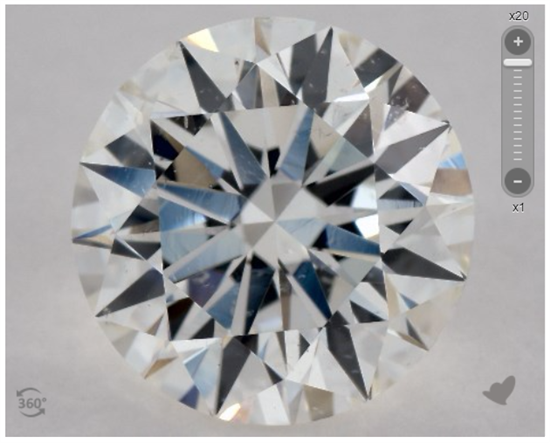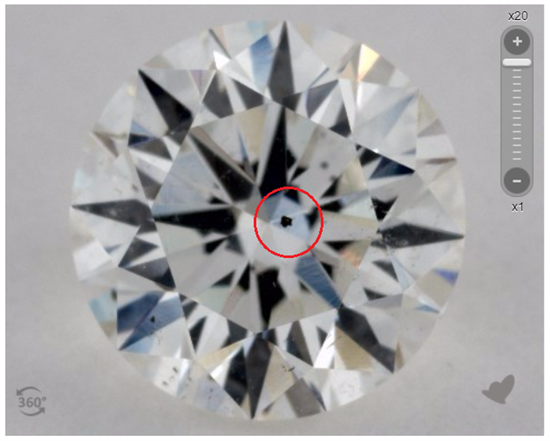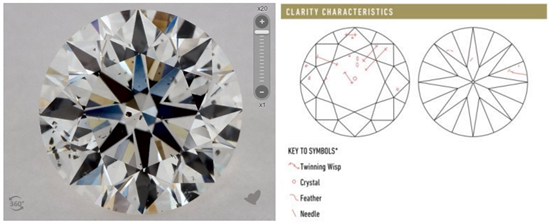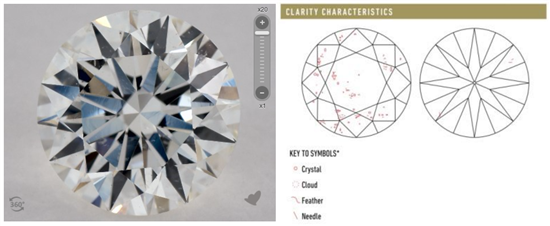SI1 Clarity Diamond: Best Value If You Buy Right
Is SI1 clarity diamond good enough? Most appear flawless to the naked eye. Read on for the pros and cons. Learn why SI1 diamonds is a smart choice for your money.
In our opinion, the clarity of the diamond is the least important factor of the 4C’s.
This is because most inclusions are too small to be seen with the naked eye. But when you start to get into the SI territory, it gets a little trickier.
We already talked at length about why VS2 diamonds offer the best bang for your buck. This is because a VS2 diamond is generally considered a safe bet, even if you have no choice but to buy a diamond sight unseen.
But in reality, you can go down to a clarity grade of SI1 and get even more value. You just have to be more careful.
In this guide, we’ll go over how to pick an SI1 diamond good enough for your engagement ring.
VS versus SI grades
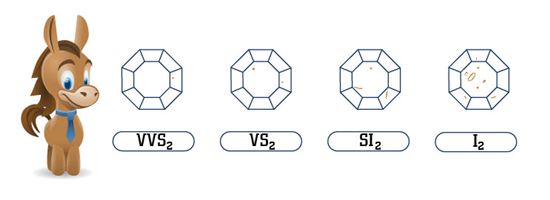 |
| Diamond Clarity Scale © CreditDonkey |
- The VS (Very Slightly Included) grade refers to diamonds that have flaws more easily noticed under magnification, but not to the naked eye. VS1 can pretty much be guaranteed to be eye-clean, while VS2 may contain some minor flaws that may be noticed under scrutiny.
- The SI (Slightly Included) grade refers to diamonds with larger flaws that are easily visible under magnification. Depending on the flaw, it may be noticeable to the naked eye. The difference between SI1 and SI2 is that SI2’s flaws are more visible.
Putting a diamond into the SI category may sound intimidating, and a lot of people assume it means that you can see the flaws. But the truth is that to most casual admirers with untrained eyes, an SI1 diamond looks no different than a VS1 or VS2 diamond (or even VVS or Flawless!).
 |
| Screenshot from James Allen Website |
Basically, what we’re saying that is that those of us who aren’t jewelers will see it as a perfectly fine rock.
But of course, if you’re buying a diamond from an online retailer without photos, then we’d recommend that you stick with VS2 to be on the safe side. Only buy a diamond rated SI if you are able to see clear, magnified photos to verify that it is eye clean.
Examples of SI1 diamonds
Here are some examples of non-eye-clean SI1 diamonds (left/right):
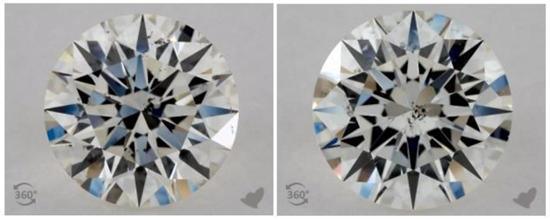 |
| Screenshot from James Allen Website |
And here are some examples of eye-clean SI diamonds (left/right):
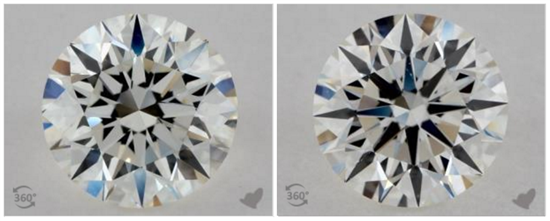 |
| Screenshot from James Allen Website |
Unfortunately, the selection is very hit or miss. Browsing through James Allen’s SI1 diamonds, it appears that about half look to be eye clean and half do not.
So now, we’re going to give you some tips for choosing an SI diamond.
Tips for shopping for SI Diamonds
- Look at the location of the inclusion. The worst locations are towards the center, right under the table facet. Inclusions more towards the edges are less noticeable and can be hidden with prongs. Inclusions in the pavilion (the bottom part) can be hidden in a bezel setting.
Be careful with this too, because having a feather inclusion near the edge (at the girdle) weakens the diamond at that point, and hitting it in the right direction could cause a chip.
- The type of inclusion makes a difference. The most visible inclusions are dark crystals right under the table facet, which will look like dust specks that you just can’t rub off. Large cloud inclusions (a cluster of pinpoints, or tiny dots) could affect the brilliance of the diamond and make it appear hazy. Feathers (small cracks in the diamond) are usually not seen with the naked eye but pose a durability risk.
![]()
This diamond has a number of clouds that are well spread out on the surface. When taken down to actual size, I believe that they will not be visible to the naked eye. The excellent cut of the diamond will hide these flaws with its sparkle.
But this diamond has an ugly, large black crystal just under the surface that can most definitely be seen.
![Screenshot from www.jamesallen.com]()
Screenshot from James Allen Website - Look at the clarity plot. Generally, diamonds 1 carat or larger will have a clarity plot on the GIA report. This plot shows you exactly what type of inclusions were found on the diamond. Usually it’s pretty accurate, so it’s not a bad idea to look at it.
For example, this messy-looking SI1 diamond has an equally messy clarity plot.
![Screenshot from www.jamesallen.com]()
Screenshot from James Allen Website Clarity plots can be looked at for reference, but don’t take it as the final word because there’s just not enough information. You won’t know the true nature of the inclusion, such as its color or size or how far under the table it’s located. You don’t know if it looks as bad as it seems on the plot, or vice versa – if it looks worse in real life. Nothing can replace seeing the diamond with your own eyes or a magnified picture.
For example, this diamond appears to be eye clean despite a scary clarity plot!
![Screenshot from www.jamesallen.com]()
Screenshot from James Allen Website It may be scary to look at these diamonds with what seems to be large inclusions. But remember that you’re looking at these images 20x magnified, so they appear a lot worse. You can use James Allen’s zoom features to resize it down to normal size and see if you’re still able to see the inclusions. Unless there’s something serious like a huge black crystal or dark cloud, we bet you can’t!
Final tips
Wondering if an SI1 diamond is the way to go? Beware of these circumstances where an SI1 wouldn’t be ideal.
- Not all shapes can get away with SI1. Diamonds cut for maximum brilliance (such as round, princess, radiant) hide flaws with their intense sparkle. But step cuts (such as asscher and emerald) have a large table that peers deep into the depth of the diamond, thus easily revealing clarity. You’ll want to go no less than a VS2. We’d even recommend VS1 if you want to be extra safe.
- Nor do larger sizes. Larger diamonds have larger facets, so it becomes harder to hide flaws. If you’re getting a diamond around 2 carats or larger, you’d probably want to stick to VS1-VS2 clarity.
- And lastly, make sure the SI1 diamond you’re buying is graded by a reputable lab. We only recommend GIA and AGS. It’s not to say that labs such as IGI and EGL aren’t legit, but their standards are generally lower. So an IGI grading of SI1 could actually be an I (Included) diamond.
Bottom Line
An SI1 diamond can be a great value if you are careful and find one that is eye clean. It’s a great way to save a considerable amount of money, so you can use that towards a better cut and/or larger rock instead.
Just be careful when choosing one, and we recommend that you NEVER buy an SI diamond sight unseen. It’s just too unpredictable, even if you’re referring to the clarity plot. We highly suggest using a site like James Allen if you’re shopping for a diamond online. That way you can see if the inclusions are something you can live with.
Write to Anna G at feedback@creditdonkey.com. Follow us on Twitter and Facebook for our latest posts.
Note: This website is made possible through financial relationships with some of the products and services mentioned on this site. We may receive compensation if you shop through links in our content. You do not have to use our links, but you help support CreditDonkey if you do.
Read Next:
